One description in the Houston Chronicle recounts how a mother grabbed two of her daughters quickly from an upstairs shower so they could hide in a closet under the stairs. Their house was destroyed, but they were unharmed. Another resident described hiding in a bathroom with his family while he held out his arms “like Superman” to try and hold the walls back from collapsing. They survived with only a three foot by three foot space to spare.
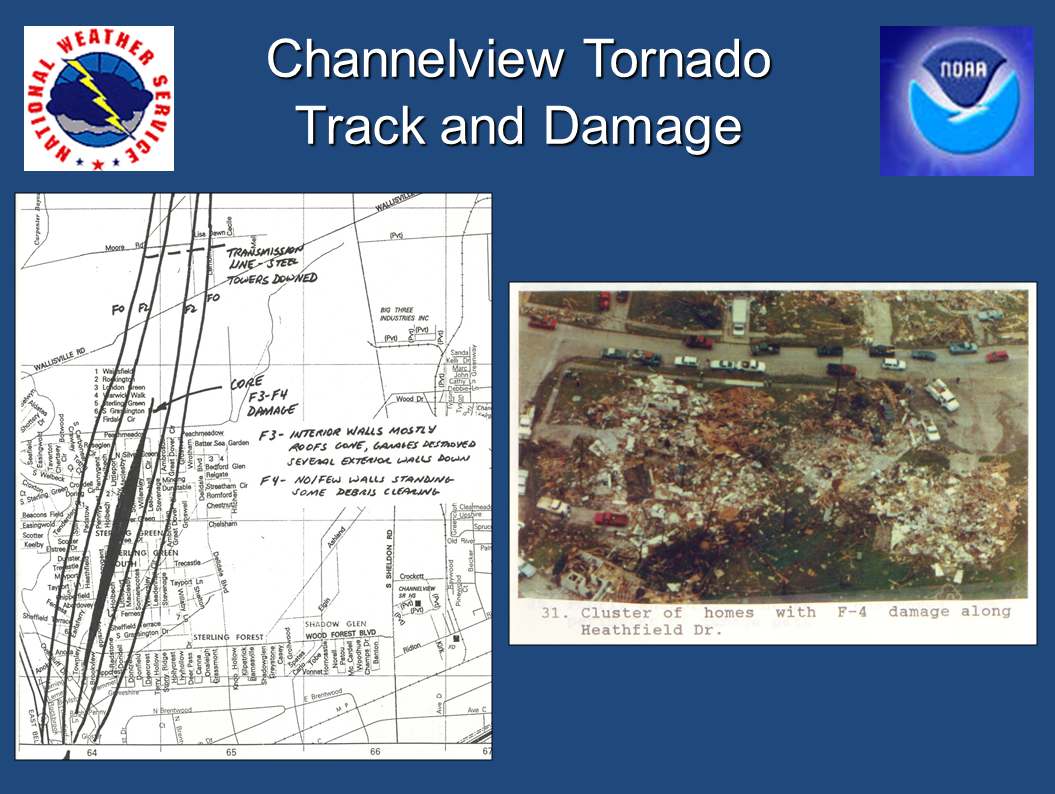
A woman told the Houston Post of a baby shower she and about 40 other people were attending for her granddaughter. They hit the floor to avoid shattering glass windows. Meanwhile, her granddaughter’s home across the street was destroyed. Another resident hid in a hallway with his son as a mobile home was carried 300 feet across the neighborhood into the top of his house.
The Harris County Archives also has video of some of the damage and recovery efforts.
Time and time again, it’s clear how miraculous it was that no one died in and around Houston that day. Channelview had 16 minutes of lead time before the tornado struck, which would be good in 2016, let alone 1992.
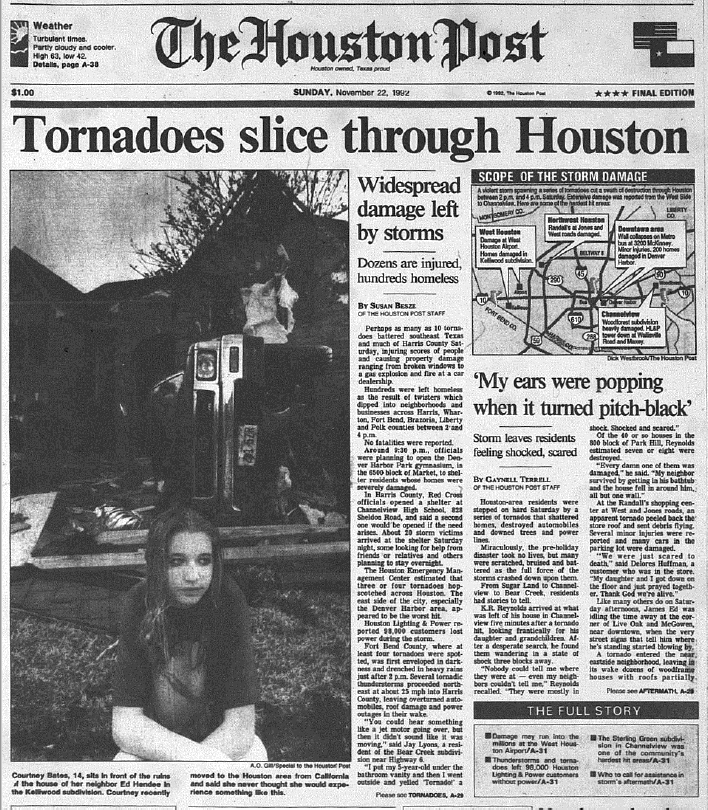
Response
A good deal of education on how to survive a tornado, coupled with absolutely phenomenal work by the Houston National Weather Service office was the likely reason fatalities numbered zero on November 21, 1992. After large events like the 1992 November tornado outbreak, NOAA typically publishes a post-mortem analysis of the event, with details on the size and scope of the event, a summary of how operations fared, and lessons learned and recommendations for the future. The NOAA report after this outbreak, published in November of 1993, showered the NWS Houston office with extreme praise. In the executive summary, they stated:
In particular, the performance at the Weather Service Office (WSO) Houston was exemplary and the value and capabilities of the recently installed WSR-88D radar there were clearly demonstrated. The Houston office issued warnings for 15 of the 17 tornado events that occurred in its area of responsibility, with an average lead time of 25 minutes.
The Houston office had predicted the event during the morning shift, leading to the office increasing staffing for the afternoon. This allowed one meteorologist to focus solely on the new radar technology to help with warnings (all of their warnings verified and only one tornado went completely unwarned, which was a tremendous accomplishment).
At that time, we were improving what meteorologists call “mesoanalysis,” which is analyzing weather on a smaller scale, say over Texas instead of over the United States as a whole. In this case, mesoanalysis contributed to a strong understanding that the atmosphere was primed for tornadoes in East Texas. Word got out about the storms well in advance, so Houstonians were prepared. And having an average lead time of 25 minutes was incredible in 1992.
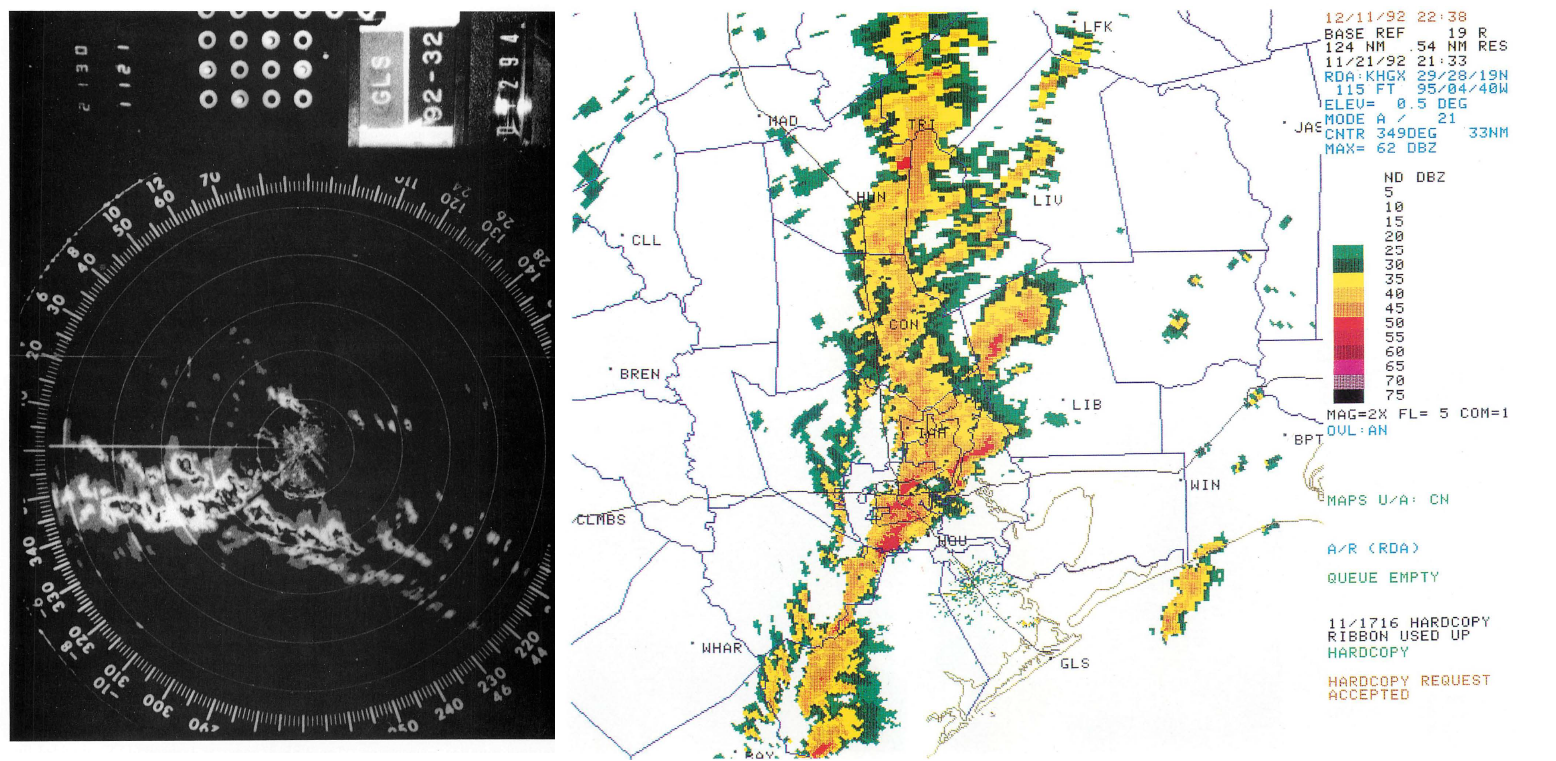
Thanks to the new radar technology and excellent training from NOAA, the NWS in Houston had an edge in forecasting that once was only a dream. One of the recommendations in the NOAA report included the idea that one meteorologist should be on “radar duty” at all times during severe weather.
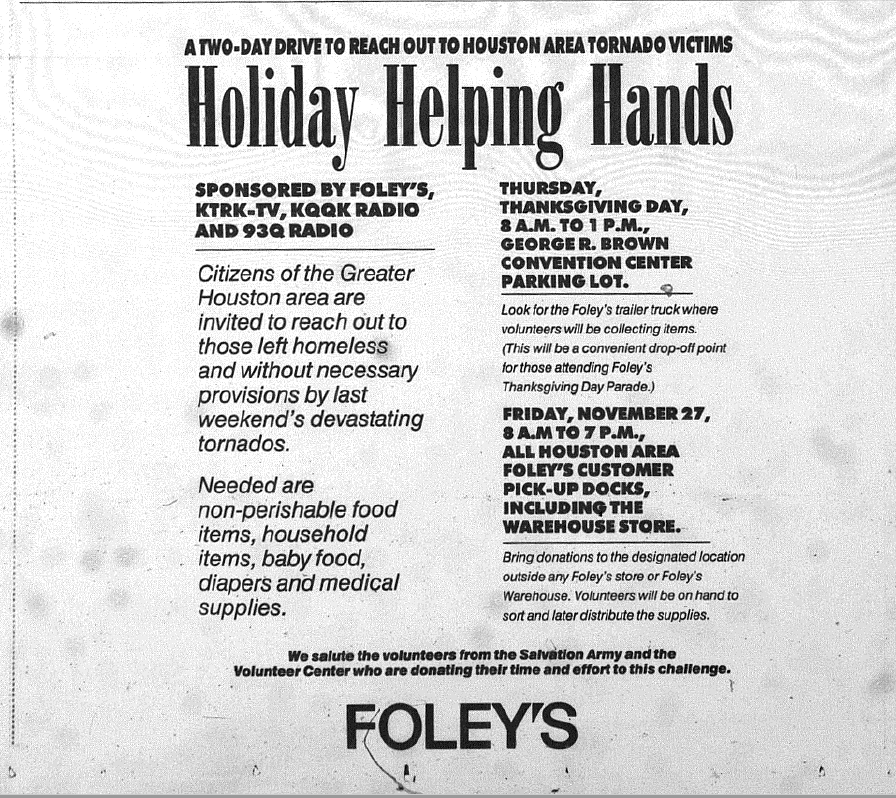
Credit is also owed to the actual victims of the storm. Most practiced proper safety techniques established during tornadoes. From the NOAA report:
Several citizens in the Channelview section of Houston, Texas where an F4 tornado had devastated a multi-block area were interviewed. Most had been aware of the possibility of tornadoes from their own knowledge of local weather or from the radio and TV forecasts. Those who were listening to radio or television heard the Tornado Warnings. Those who were busy with outside activities or shopping did not hear the warnings. However, those in the vicinity of the tornado all described its intense blackness, the roaring sounds of freight trains and the debris funnel. The tornado was clearly visible. Many Houston citizens have been trained since third grade on the correct actions to take during tornadoes, and, in all cases, they saved their own lives.
The combination of good forecasting and analysis, fantastic work at NWS Houston, and Southeast Texans implementing proper safety techniques during the event, limited injuries and prevented loss of life. Given the circumstances, it’s hard to imagine a better outcome from this event.
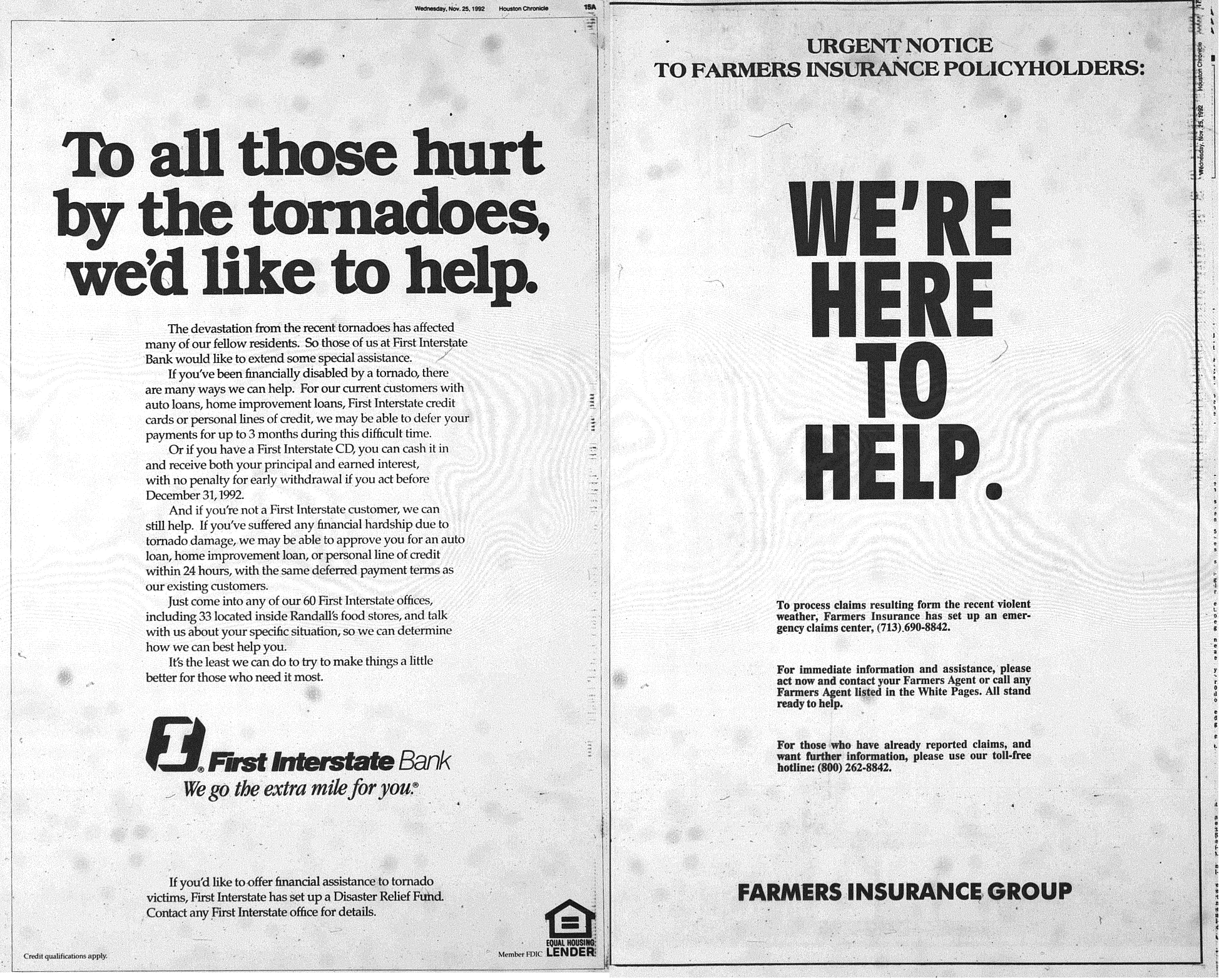
From reading accounts after the event, the response was what one would expect from Houston: Many offered victims of the storms aid, shelter, clean up assistance, and on and on. The typical generosity and concern for neighbors was on display throughout the region.
The takeaway message here is simple: While an outbreak of this magnitude represents an outlier for Southeast Texas, the fact is that it can happen here. Know how to respond to a tornado. Have a plan ready if a tornado is about to bear down on your home. You should also have a method to receive weather warnings at night or when you may be distracted. Recall, last October we had several tornadoes occur during the pre-dawn hours while most of us were asleep. A simple alert could end up saving your life in this situation. Back in 1992, people responded well to the threat, and thanks to their knowledge and the impressive work at the Houston NWS office at the time, the death toll was zero. For an event like the November 1992 tornado outbreak, that’s a wonderful thing.
(Post continues on next page)
My wife and I will always remember that day! We were married at St. Paul’s UMC on that blustery Saturday. Celebrating our 24th anniversary today.
Happy anniversary! Quite a memorable day for many reasons!
Brings back memories that had been filed away. Yet another reason for reliving these events. Not only for new residents for obvious reasons, but also for longer time residents as well. Certainly not sensationalism, but a gentle poke that things do happen and what we can do to raise our odds of survival.
Though not directly personally affected, I was a public school teacher of a sixth grade campus that served Pecan Grove at the time. The damage to a Randall’s grocery store (Jones Rd and West; now an HEB) was within a mile of the homestead.
Excellent job of reporting. Looking forward to future installments.
Thanks Timothy!
I was just a 13-year-old middle school kid from Sterling Green South in Channelview when this happened (ironically, we were nearer the Kelliwood tornadoes — shopping far from home at West Oaks Mall — when we first learned about what was going on), but I credit the entire experience — and especially helping many of our fellow church members with damaged and destroyed homes in the Sterling Green subdivision — with developing my interest in weather that now makes me appreciate this blog so much.
Thanks for sharing your story (and for the compliments), Justin! Had to be quite an experience.
I am looking forward to future articles in your retrospective series.
In ’92 I was a student at Rice working late in the library on the Saturday before Thanksgiving. I remember it was around 3PM and I looked east from the 3rd floor lounge and saw the blackest sky I have ever seen before or since, moving west. Decided to get out and go home before I might be stuck in thunderstorms.
There wasn’t much weather on my way home, just some rain and wind. However later that day and for the next week the media were full or reports of the local tornadoes that had hit so severely just before the holiday.
PS I remember this also because there was really no forewarning. I was a weather radio fan at the time and recall it was strange that there was no NWS warning for what seemed to be such bad weather coming in. For a few years afterward, local radio and tv went overboard and exaggerated almost any threat of bad weather. That’s how I remember it. Took them years to shake this habit and now we have in my opinion situations in which the media either exaggerate the danger, or overlook it almost completely.
Thanks for sharing your story!
It’s interesting, as the post-storm analysis really commended the NWS for adequate warnings and good lead time (actually, amazingly good for the early 90s). I wonder why that happened. Maybe there was a transmitter issue…will have to go back and see.
I, too, was a Rice student at that time. I remember that we were playing Navy that afternoon, and if Rice won, we would have our first winning football season in who knows how many years. The game was paused in the third quarter while the tornadoes passed by, but it was not cancelled. Morning heat gave way to a wet, cold afternoon. [I learned to recognize that pattern, but at that time I had been living in Houston for about three months.] The field was drenched, as was the audience. Both the MOB and the Navy band moved undercover during the pause, and they played impromptu concerts until the game resumed. The atmosphere at Rice Stadium was festive and unworried.I knew that windows were blown out downtown, but I had no idea of the widespread severity of damage until much later.
Rice did beat Navy that afternoon.
Thanks for sharing with us! Interesting to hear people’s perspectives years later.
Thank you for this well-researched and informative article. Fascinating – and a good reminder not to let our guards down when it comes to severe storms.
I very much appreciate the research and reporting that went into this story & look forward to more retrospectives on Houston’s wild weather.
Thanks so much, Sharon!
I truly enjoyed reading this.
I’ve always remembered the TV images of the planes flipped upside down at the West Houston airport.
That was my gold Jeep Cherokee on the front page. If I am not mistaken that same pic was on USA Today as well.
I ran next door and called 911 at Little Ceasars.
Me and many of my friends were working sacking at Randall’s. It was a extremely busy Thanksgiving shopping day.
Thanks for sharing your story, Chris. Incredible stuff!
That’s me in the middle of the front page. I was working the checkout right in front of the entry. I had just gotten to work and to my register, and I remember the sky was clear on my drive in.
After the store was hit and all the emergency crews got there, I remember they made us all go back into the freezer because another one was forming.
We lived on the corner of South Silver Green and MacClesby when this storm hit. We heard warnings for Wharton and Waller County, but that seemed so far away. I remember looking out the window and wondering what all the fuss was about because it was barely sprinkling and no wind. Then I saw a small dark wispy cloud (like a puff of smoke) just over the rooftops, moving really fast. I called my husband to the window so he could see the strange cloud and as soon as he got to the window, we saw the transformers blowing up behind us in Sterling Green South. That’s when we saw the tornado – we raised the living room window where we stood, grabbed the 2 dogs and made it almost to the hall before the windows started blowing out. Our garage was ripped off the house, nothing left but a pile of bricks and the roof was lifted and set back down crooked. Our washer and dryer ended up in the middle of the street and someone’s mattress was tangled in our tree. Our neighbor had a 2×4 stuck in the engine of his truck and we found clothes that didn’t belong to us in the living room. We couldn’t eat much for 2 days because our throats were so swollen from all the insulation we breathed. The Salvation Army served breakfast in our backyard for a couple days afterwards and the news stations set-up next to the house. Until I read this article, I didn’t realize we were dead-center of the path. Gave me chills, remembering. To this day I still don’t understand why it wasn’t raining or the wind wasn’t blowing – it was just an overcast afternoon.
Thanks for sharing your story. I was wondering if we’d hear some first-hand accounts from readers on this eventually. Really incredible. I’m glad you were able to escape without being too seriously hurt.
Small world. Remembering this on the 25th anniversary. I happened to be at a friend’s house in the 1400 block of Macclesby when the tornado hit. We lived around the corner on Rockington Ln. Was a crazy experience. I remember running home after in the rain to check on my parents and sister. Luckily, they hid in the restroom and survived. The house, not so much. The tornado took the whole roof off the house and the garage caved in. Never forget that day.